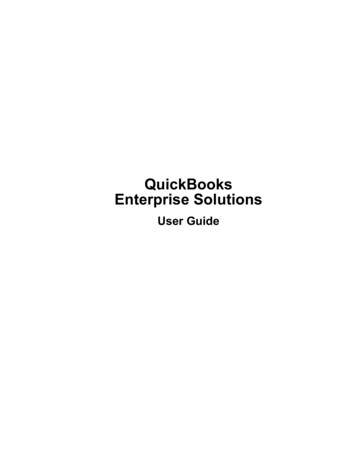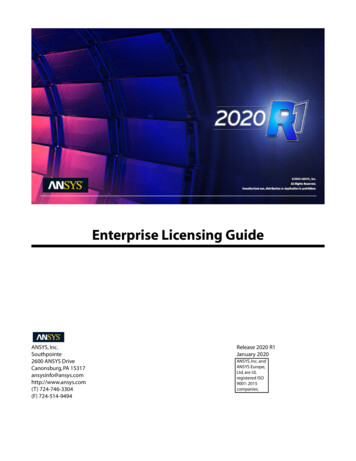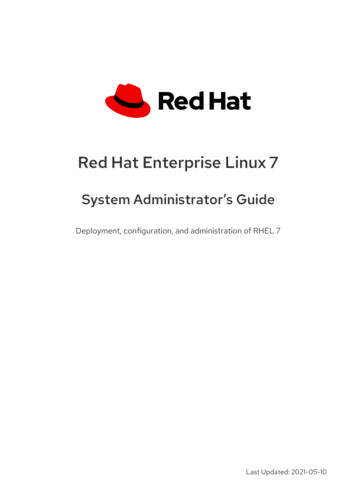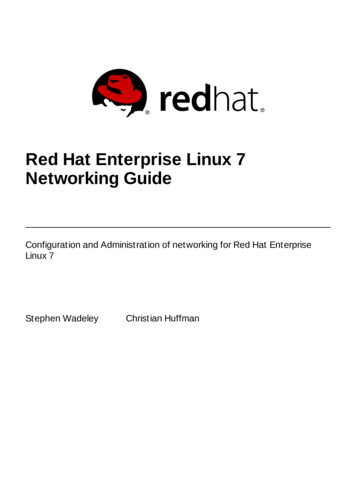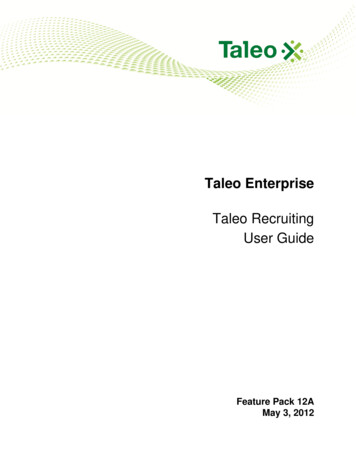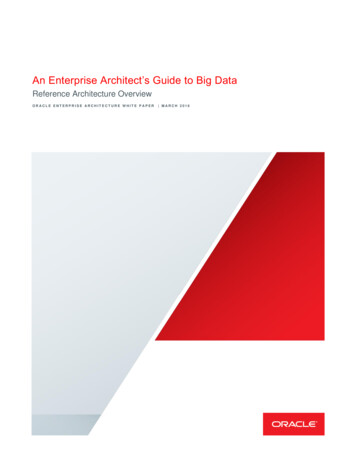
Transcription
An Enterprise Architect’s Guide to Big DataReference Architecture OverviewORACLE ENTERPRISE ARCHITECT URE WHITE PAPER MARCH 2016
DisclaimerThe following is intended to outline our general product direction. It is intended for informationpurposes only, and may not be incorporated into any contract. It is not a commitment to deliver anymaterial, code, or functionality, and should not be relied upon in making purchasing decisions. Thedevelopment, release, and timing of any features or functionality described for Oracle’s productsremains at the sole discretion of Oracle.ORACLE ENTERPRISE ARCHITECTURE WHITE PAPER — AN ENTERPRISE ARCHITECT’S GUIDE TO BIG DATA
Table of ContentsExecutive SummaryA Pointer to Additional Architecture Materials13Fundamental ConceptsWhat is Big Data?The Big Questions about Big DataWhat’s Different about Big Data?4457Taking an Enterprise Architecture Approach11Big Data Reference Architecture OverviewTraditional Information Architecture CapabilitiesAdding Big Data CapabilitiesA Unified Reference ArchitectureEnterprise Information Management CapabilitiesBig Data Architecture Capabilities141414161718Oracle Big Data Cloud Services23Highlights of Oracle’s Big Data ArchitectureBig Data SQLData IntegrationOracle Big Data ConnectorsOracle Big Data PreparationOracle Stream ExplorerSecurity ArchitectureComparing Business Intelligence, Information Discovery, and AnalyticsData VisualizationSpatial and Graph Analysis24242627282930313335Extending the Architecture to the Internet of Things36Big Data Architecture Patterns in Three Use CasesUse Case #1: Retail Web Log AnalysisUse Case #2: Financial Services Real-time Risk DetectionUse Case #3: Driver Insurability using Telematics38383941Big Data Best Practices43Final Thoughts45ORACLE ENTERPRISE ARCHITECTURE WHITE PAPER — AN ENTERPRISE ARCHITECT’S GUIDE TO BIG DATA
Executive SummaryToday, Big Data is commonly defined as data that contains greater variety arriving in increasingvolumes and with ever higher velocity. Data growth, speed and complexity are being driven bydeployment of billions of intelligent sensors and devices that are transmitting data (popularly called theInternet of Things) and by other sources of semi-structured and structured data. The data must begathered on an ongoing basis, analyzed, and then provide direction to the business regardingappropriate actions to take, thus providing value.Most are keenly aware that Big Data is at the heart of nearly every digital transformation taking placetoday. For example, applications enabling better customer experiences are often powered by smartdevices and enable the ability to respond in the moment to customer actions. Smart products beingsold can capture an entire environmental context. Business analysts and data scientists aredeveloping a host of new analytical techniques and models to uncover the value provided by this data.Big Data solutions are helping to increase brand loyalty, manage personalized value chains, uncovertruths, predict product and consumer trends, reveal product reliability, and discover real accountability.IT organizations are eagerly deploying Big Data processing, storage and integration technologies in onpremises and Public Cloud-based solutions. Cloud-based Big Data solutions are hosted onInfrastructure as a Service (IaaS), delivered as Platform as a Service (PaaS), or as Big Dataapplications (and data services) via Software as a Service (SaaS) manifestations. Each must meetcritical Service Level Agreements (SLAs) for the business intelligence, analytical and operationalsystems and processes that they are enabling. They must perform at scale, be resilient, secure andgovernable. They must also be cost effective, minimizing duplication and transfer of data wherepossible. Today’s architecture footprints can now be delivered consistently to these standards. Oraclehas created reference architectures for all of these deployment models.There is good reason for you to look to Oracle as the foundation for your Big Data capabilities. Sinceits inception, 35 years ago, Oracle has invested deeply across nearly every element of informationmanagement – from software to hardware and to the innovative integration of both on premises andCloud-based solutions. Oracle’s family of data management solutions continue to solve the toughesttechnological and business problems delivering the highest performance on the most reliable,available and scalable data platforms. Oracle continues to deliver ancillary data managementcapabilities including data capture, transformation, movement, quality, security, and managementwhile providing robust data discovery, access, analytics and visualization software. Oracle’s uniquevalue is its long history of engineering the broadest stack of enterprise-class information technology to1 ORACLE ENTERPRISE ARCHITECTURE WHITE PAPER — AN ENTERPRISE ARCHITECT’S GUIDE TO BIG DATA
work together—to simplify complex IT environments, reduce TCO, and to minimize the risk when newareas emerge – such as Big Data.Oracle thinks that Big Data is not an island. It is merely the latest aspect of an integrated enterpriseclass information management capability. Looked at on its own, Big Data can easily add to thecomplexity of a corporate IT environment as it evolves through frequent open source contributions,expanding Cloud-based offerings, and emerging analytic strategies. Oracle’s best-of-breed products,support, and services can provide the solid foundation for your enterprise architecture as you navigateyour way to a safe and successful future state.To deliver to business requirements and provide value, architects must evaluate how to efficientlymanage the volume, variety, velocity of this new data across the entire enterprise informationarchitecture. Big Data goals are not any different than the rest of your information management goals– it’s just that now, the economics and technology are mature enough to process and analyze thisdata.This paper is an introduction to the Big Data ecosystem and the architecture choices that an enterprisearchitect will likely face. We define key terms and capabilities, present reference architectures, anddescribe key Oracle products and open source solutions. We also provide some perspectives andprinciples and apply these in real-world use cases. The approach and guidance offered is thebyproduct of hundreds of customer projects and highlights the decisions that customers faced in thecourse of their architecture planning and implementations.Oracle’s architects work across many industries and government agencies and have developed astandardized methodology based on enterprise architecture best practices. These should look familiarto architects familiar with TOGAF and other best architecture practices. Oracle’s enterprisearchitecture approach and framework are articulated in the Oracle Architecture Development Process(OADP) and the Oracle Enterprise Architecture Framework (OEAF).2 ORACLE ENTERPRISE ARCHITECTURE WHITE PAPER — AN ENTERPRISE ARCHITECT’S GUIDE TO BIG DATA
A Pointer to Additional Architecture MaterialsOracle offers additional documents that are complementary to this white paper. A few of these are described below:IT Strategies from Oracle (ITSO) is a series of practitioner guides and reference architectures designed toenable organizations to develop an architecture-centric approach to enterprise-class IT initiatives. ITSO presentssuccessful technology strategies and solution designs by defining universally adopted architecture concepts,principles, guidelines, standards, and patterns.The Big Data and Analytics Reference Architecture paper (39 pages) offers a logical architecture and Oracle productmapping. The Information Management Reference Architecture (200 pages) covers the information managementaspects of the Oracle Reference Architecture and describes important concepts, capabilities, principles,technologies, and several architecture views including conceptual, logical, product mapping, and deployment viewsthat help frame the reference architecture. The security and management aspects of information management arecovered by the ORA Security paper (140 pages) and ORA Management and Monitoring paper (72 pages). Otherrelated documents in this ITSO library include cloud computing, business analytics, business process management,or service-oriented architecture.The Information Management and Big Data Reference Architecture (30 pages) white paper offers a thoroughoverview for a vendor-neutral conceptual and logical architecture for Big Data. This paper will help you understandmany of the planning issues that arise when architecting a Big Data capability.Examples of the business context for Big Data implementations for many companies and organizations appears inthe industry whitepapers posted on the Oracle Enterprise Architecture web site. Industries covered includeagribusiness, communications service providers, education, financial services, healthcare payers, healthcareproviders, insurance, logistics and transportation, manufacturing, media and entertainment, pharmaceuticals and lifesciences, retail, and utilities.Lastly, numerous Big Data materials can be found on Oracle Technology Network (OTN) and Oracle.com/BigData.3 ORACLE ENTERPRISE ARCHITECTURE WHITE PAPER — AN ENTERPRISE ARCHITECT’S GUIDE TO BIG DATA
Fundamental ConceptsWhat is Big Data?Historically, a number of the large-scale Internet search, advertising, and social networking companies pioneeredBig Data hardware and software innovations. For example, Google analyzes the clicks, links, and content on 1.5trillion page views per day (www.alexa.com) – and delivers search results plus personalized advertising inmilliseconds! This is a remarkable feat of computer science engineering.As Google, Yahoo, Oracle, and others have contributed their technology to the open source community, broadercommercial and public sector interest took up the challenge of making Big Data work for them. Unlike the pioneers,the broader market sees big data slightly differently. Rather than the data interpreted independently, they see thevalue realized by adding the new data to their existing operational or analytical systems.So, Big Data describes a holistic information management strategy that includes and integrates many new types ofdata and data management alongside traditional data. While many of the techniques to process and analyze thesedata types have existed for some time, it has been the massive proliferation of data and the lower cost computingmodels that have encouraged broader adoption. In addition, Big Data has popularized two foundational storage andprocessing technologies: Apache Hadoop and the NoSQL database.Big Data has also been defined by the four “V”s: Volume, Velocity, Variety, and Value. These become a reasonabletest to determine whether you should add Big Data to your information architecture.» Volume. The amount of data. While volume indicates more data, it is the granular nature of the data that isunique. Big Data requires processing high volumes of low-density data, that is, data of unknown value, such astwitter data feeds, clicks on a web page, network traffic, sensor-enabled equipment capturing data at the speed oflight, and many more. It is the task of Big Data to convert low-density data into high-density data, that is, data thathas value. For some companies, this might be tens of terabytes, for others it may be hundreds of petabytes.» Velocity. A fast rate that data is received and perhaps acted upon. The highest velocity data normally streamsdirectly into memory versus being written to disk. Some Internet of Things (IoT) applications have health andsafety ramifications that require real-time evaluation and action. Other internet-enabled smart products operate inreal-time or near real-time. As an example, consumer eCommerce applications seek to combine mobile devicelocation and personal preferences to make time sensitive offers. Operationally, mobile application experienceshave large user populations, increased network traffic, and the expectation for immediate response.» Variety. New unstructured data types. Unstructured and semi-structured data types, such as text, audio, andvideo require additional processing to both derive meaning and the supporting metadata. Once understood,unstructured data has many of the same requirements as structured data, such as summarization, lineage,auditability, and privacy. Further complexity arises when data from a known source changes without notice.Frequent or real-time schema changes are an enormous burden for both transaction and analytical environments.» Value. Data has intrinsic value—but it must be discovered. There are a range of quantitative and investigativetechniques to derive value from data – from discovering a consumer preference or sentiment, to making arelevant offer by location, or for identifying a piece of equipment that is about to fail. The technologicalbreakthrough is that the cost of data storage and compute has exponentially decreased, thus providing anabundance of data from which statistical sampling and other techniques become relevant, and meaning can bederived. However, finding value also requires new discovery processes involving clever and insightful analysts,business users, and executives. The real Big Data challenge is a human one, which is learning to ask the rightquestions, recognizing patterns, making informed assumptions, and predicting behavior.4 ORACLE ENTERPRISE ARCHITECTURE WHITE PAPER — AN ENTERPRISE ARCHITECT’S GUIDE TO BIG DATA
The Big Questions about Big DataThe good news is that everyone has questions about Big Data! Both business and IT are taking risks andexperimenting, and there is a healthy bias by all to learn. Oracle’s recommendation is that as you take this journey,you should take an enterprise architecture approach to information management; that big data is an enterprise assetand needs to be managed from business alignment to governance as an integrated element of your currentinformation management architecture. This is a practical approach since we know that as you transform from aproof of concept to run at scale, you will run into the same issues as other information management challenges,namely, skill set requirements, governance, performance, scalability, management, integration, security, andaccess. The lesson to learn is that you will go further faster if you leverage prior investments and training.Here are some of the common questions that enterprise architects face:THE BIG DATA QUESTIONSAreasQuestionsPossible AnswersBusiness IntentHow will we make use of the data?»»»»»Business UsageWhich business processes can benefit?» Operational ERP/CRM systems» BI and Reporting systems» Predictive analytics, modeling, data miningData OwnershipDo we need to own (and archive) the data?»»»»ProprietaryRequire historical dataEnsure lineageGovernanceIngestionWhat are the sense and respond characteristics?»»»»»Sensor-based real-time eventsNear real-time transaction eventsReal-time analyticsNear real time analyticsNo immediate analyticsData StorageWhat storage technologies are best for our datareservoir?»»»»»HDFS (Hadoop plus others)File systemData WarehouseRDBMSNoSQL databaseData ProcessingWhat strategy is practical for my application?»»»»Leave it at the point of captureAdd minor transformationsETL data to analytical platformExport data to desktopsPerformanceHow to maximize speed of ad hoc query, datatransformations, and analytical modeling?»»»»»»»Analyze and transform data in real-timeOptimize data structures for intended useUse parallel processingIncrease hardware and memoryDatabase configuration and operationsDedicate hardware sandboxesAnalyze data at rest, in-placeLatencyHow to minimize latency between key operationalcomponents? (ingest, reservoir, data warehouse,» Share storage» High speed interconnectBusiness ContextSell new products and servicesPersonalize customer experiencesSense product maintenance needsPredict risk, operational resultsSell value-added dataArchitecture Vision5 ORACLE ENTERPRISE ARCHITECTURE WHITE PAPER — AN ENTERPRISE ARCHITECT’S GUIDE TO BIG DATA
AreasQuestionsPossible Answersreporting, sandboxes)» Shared private network» VPN - across public networksAnalysis & DiscoveryWhere do we need to do analysis?»»»»»»»At ingest – real time evaluationIn a raw data reservoirIn a discovery labIn a data warehouse/martIn BI reporting toolsIn the public cloudOn premisesSecurityWhere do we need to secure the data?»»»»»In memoryNetworksData ReservoirData WarehouseAccess through tools and discovery labUnstructured Data ExperienceIs unstructured or sensor data being processed insome way today?(e.g. text, spatial, audio, video)»»»»»Departmental projectsMobile devicesMachine diagnosticsPublic cloud data captureVarious systems log filesConsistencyHow standardized are data quality and governancepractices?» Comprehensive» LimitedOpen Source ExperienceWhat experience do we have in open source Apacheprojects? (Hadoop, NoSQL, etc)»»»»Analytics SkillsTo what extent do we employ Data Scientists andAnalysts familiar with advanced and predictiveanalytics tools and techniques?» Yes» NoBest PracticesWhat are the best resources to guide decisions tobuild my future state?»»»»»»Data TypesHow much transformation is required for rawunstructured data in the data reservoir?» None» Derive a fundamental understanding withschema or key-value pairs» Enrich dataData SourcesHow frequently do sources or content structurechange?» Frequently» Unpredictable» NeverData QualityWhen to apply transformations?»»»»»Discovery ProvisioningHow frequently to provision discovery labsandboxes?» Seldom» FrequentlyCurrent StateScattered experimentsProof of conceptsProduction experienceContributorFuture StateReference architectureDevelopment patternsOperational processesGovernance structures and policesConferences and communities of interestVendor best practicesIn the networkIn the reservoirIn the data warehouseBy the user at point of useAt run time6 ORACLE ENTERPRISE ARCHITECTURE WHITE PAPER — AN ENTERPRISE ARCHITECT’S GUIDE TO BIG DATA
AreasQuestionsPossible AnswersProof of ConceptWhat should the POC validate before we moveforward?»»»»Open Source SkillsHow to acquire open source skills?» Cross-train employees» Hire expertise» Use experienced vendors/partnersAnalytics SkillsHow to acquire analytical skills?» Cross-train employees» Hire expertise» Use experienced vendors/partnersCloud Data SourcesHow to guarantee trust from cloud data sources?» Manage directly» Audit» AssumeData QualityHow to clean, enrich, dedup unstructured data?» Use statistical sampling» Normal techniquesData QualityHow frequently do we need to re-validate contentstructure?» Upon every receipt» Periodically» Manually or automaticallySecurity PoliciesHow to extend enterprise data security policies?»»»»RoadmapBusiness use caseNew technology understandingEnterprise integrationOperational implicationsGovernanceInherit enterprise policiesCopy enterprise policiesOnly authorize specific tools/access pointsLimited to monitoring security logsWhat’s Different about Big Data?Big Data introduces new technology, processes, and skills to your information architecture and the people thatdesign, operate, and use them. With new technology, there is a tendency to separate the new from the old, but westrongly urge you to resist this strategy. While there are exceptions, the fundamental expectation is that findingpatterns in this new data enhances your ability to understand your existing data. Big Data is not a silo, nor shouldthese new capabilities be architected in isolation.At first glance, the four “V”s define attributes of Big Data, but there are additional best-practices from enterpriseclass information management strategies that will ensure Big Data success. Below are some important realizationsabout Big Data:Information Architecture Paradigm ShiftBig data approaches data structure and analytics differently than traditional information architectures. A traditionaldata warehouse approach expects the data to undergo standardized ETL processes and eventually map into predefined schemas, also known as “schema on write”. A criticism of the traditional approach is the lengthy process tomake changes to the pre-defined schema. One aspect of the appeal of Big Data is that the data can be capturedwithout requiring a ‘defined’ data structure. Rather, the structure will be derived either from the data itself or throughother algorithmic process, also known as “schema on read.” This approach is supported by new low-cost, inmemory parallel processing hardware/software architectures, such as HDFS/Hadoop and Spark.7 ORACLE ENTERPRISE ARCHITECTURE WHITE PAPER — AN ENTERPRISE ARCHITECT’S GUIDE TO BIG DATA
In addition, due to the large data volumes, Big Data also employs the tenet of “bringing the analytical capabilities tothe data” versus the traditional processes of “bringing the data to the analytical capabilities through staging,extracting, transforming and loading,” thus eliminating the high cost of moving data.Unifying Information Requires GovernanceCombining Big Data with traditional data adds additional context and provides the opportunity to deliver even greaterinsights. This is especially true in use cases where with key data entities, such as customers and products. In theexample of consumer sentiment analysis, capturing a positive or negative social media comment has some value,but associating it with your most or least profitable customer makes it far more valuable.Hence, organizations have the governance responsibility to align disparate data types and certify data quality.Decision makers need to have confidence in the derivation of data regardless of its source, also known as datalineage. To design in data quality you need to define common definitions and transformation rules by source andmaintain through an active metadata store. The powerful statistical and semantic tools can enable you to find theproverbial needle in the haystack, and can help you predict future events with relevant degrees of accuracy, but onlyif the data is believable.Big Data Volume Keeps GrowingOnce committed to Big Data, it is a fact that the data volume will keep growing – maybe even exponentially. In yourthroughput planning, beyond estimating the basics, such as storage for staging, data movement, transformations,and analytics processing, think about whether the new technologies can reduce latencies, such as parallelprocessing, machine learning, memory processing, columnar indexing, and specialized algorithms. In addition, it isalso useful to distinguish which data could be captured and analyzed in a cloud service versus on premises.Big Data Requires Tier 1 Production GuaranteesOne of the enabling conditions for big data has been low cost hardware, processing, and storage. However, highvolumes of low cost data on low cost hardware should not be misinterpreted as a signal for reduced service levelagreement (SLA) expectations. Once mature, production and analytic uses of Big Data carry the same SLAguarantees as other Tier 1 operational systems. In traditional analytical environments users report that, if theirbusiness analytics solution were out of service for up to one hour, it would have a material negative impact onbusiness operations. In transaction environments, the availability and resiliency commitment are essential forreliability. As the new Big Data components (data sources, repositories, processing, integrations, network usage,and access) become integrated into both standalone and combined analytical and operational processes,enterprise-class architecture planning is critical for success.While it is reasonable to experiment with new technologies and determine the fit of Big Data techniques, you willsoon realize that running Big Data at scale requires the same SLA commitment, security policies, and governanceas your other information systems.Big Data Resiliency MetricsOperational SLAs typically include two key related IT management metrics: Recovery Point Objective (RPO) andRecovery Time Objective (RTO). RPO is the agreement for acceptable data loss. RTO is the targeted recoverytime for a disrupted business process. In a failure operations scenario, hardware and software must be recoverableto a point in time. While Hadoop and NoSQL include notable high availability capabilities with multi-site failover and8 ORACLE ENTERPRISE ARCHITECTURE WHITE PAPER — AN ENTERPRISE ARCHITECT’S GUIDE TO BIG DATA
recovery and data redundancy, the ease of recovery was never a key design goal. Your enterprise design goalshould be to provide for resiliency across the platform.Big Data SecurityBig Data requires the same security principles and practices as the rest of your information architecture. Enterprisesecurity management seeks to centralize access, authorize resources, and govern through comprehensive auditpractices. Adding a diversity of Big Data technologies, data sources, and uses adds requirements to thesepractices. A starting point for a Big Data security strategy should be to align with the enterprise practices andpolicies already established, avoid duplicate implementations, and manage centrally across the environments.Oracle has taken an integrated approach across a few of these areas. From a governance standpoint, Oracle AuditVault monitors Oracle and non-Oracle (HDFS, Hadoop, MapReduce, Oozie, Hive) database traffic to detect andblock threats, as well as improve compliance reporting by consolidating audit data from databases, operatingsystems, directories, files systems, and other sources into a secure centralized repository. From data accessstandpoint, Big Data SQL enables standard SQL access to Hadoop, Hive, and NoSQL with the associated SQL andRBAC security capabilities: querying encrypted data and rules enforced redaction using the virtual private databasefeatures. Your enterprise design goal should be to secure all your data and be able to prove it.Big Data and Cloud ComputingIn today’s complex environments, data comes from everywhere. Inside the company, you have known structuredanalytical and operational sources in addition to sources that you may have never thought to use before, such as logfiles from across the technology stack. Outside the company, you own data across your enterprise SaaS and PaaSapplications. In addition, you are acquiring and licensing data from both free and subscription public sources – all ofwhich vary in structure, quality and volume. Without a doubt, cloud computing will play an essential role for manyuse cases: as a data source, providing real-time streams, analytical services, and as a device transaction hub.Logically, the best strategy is move the analytics to the data, but in the end there are decisions to make. Thephysical separation of data centers, distinct security policies, ownership of data, and data quality processes, inaddition to the impact of each of the four Vs requires architecture decisions. So, this begs an important distributedprocessing architecture. Assuming multiple physical locations of large quantities of data, what is the design patternfor a secure, low-latency, possibly real-time, operational and analytic solution?Big Data Discovery ProcessWe stated earlier that data volume, velocity, variety and value define Big Data, but the unique characteristic of BigData is the process in which value is discovered. Big Data is unlike conventional business intelligence, where thesimple reporting of a known value reveals a fact, such as summing daily sales into year-to-date sales. With BigData, the goal is to be clever enough to discover patterns, model hypothesis, and test your predictions. Forexample, value is discovered through an investigative, iterative querying and/or modeling process, such as asking aquestion, make a hypothesis, choose data sources, create statistical, visual, or semantic models, evaluate findings,ask more questions, make a new hypothesis – and then start the process again. Subject matter experts interpretingvisualizations or making interactive knowledge-based queries can be aided by developing ‘machine learning’adaptive algorithms that can further discover meaning. If your goal is to stay current with the pulse of the data thatsurrounds you, you will find that Big Data investigations are continuous. And your discoveries may result in one-offdecisions or may become the new best practice and incorporated into operational business processes.The architectural point is that the discovery and modeling processes must be fast and encourage iterative,orthogonal thinking. Many recent technology innovations enable these capabilities and should be considered, such9 ORACLE ENTERPRISE ARCHITECTURE WHITE PAPER — AN ENTERPRISE ARCHITECT’S GUIDE TO BIG DATA
as memory-rich servers for caches and processing, fast networks, optimized storage, columnar indexing,visualizations, machine learning, and semantic analysis to name a few. Your enterprise design goal should be todiscover and predict fast.Unstructured Data and Data QualityEmbracing data variety, that is, a variable schema in a variety of file formats requires continuous diligence. Whilevariety offers flexibility, it also requires additional attention to understand the data, possibly clean and transform thedata, provide lineage, and over time ensure that the data continues to mean what you expect it to mean. There areboth manual and automated techniques to maintain your unstructured data quality. Examples of unstructured files:an XML file with an accompanying text-based schema declarations, text-based log files, standalone text, audio/videofiles, and key-value pairs – a two column table without predefined semantics.For use cases with an abundance of public data sources, whether structured, semi-structured, or unstructured, youmust expect that t
ORACLE ENTERPRISE ARCHITECTURE WHITE PAPER — AN ENTERPRISE ARCHITECT’S GUIDE TO BIG DATA Disclaimer The following is intended to outline our general product direction. It is intended for information purposes only, and may not be incorporated


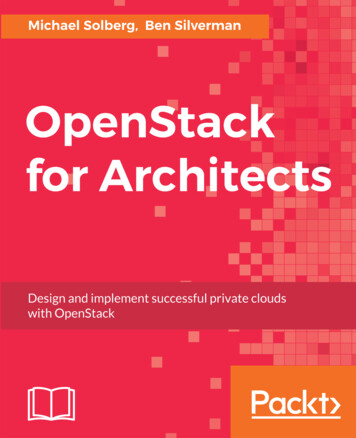
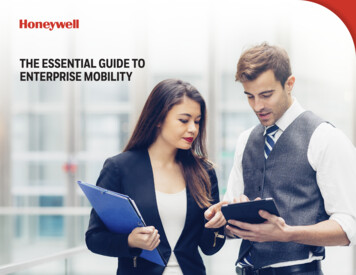
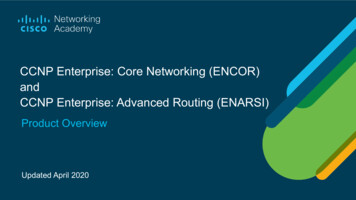
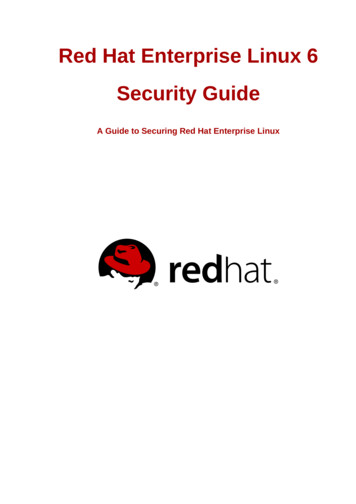
![[1]Oracle Enterprise Data Quality Administration Guide .](/img/1/e55999-01.jpg)
